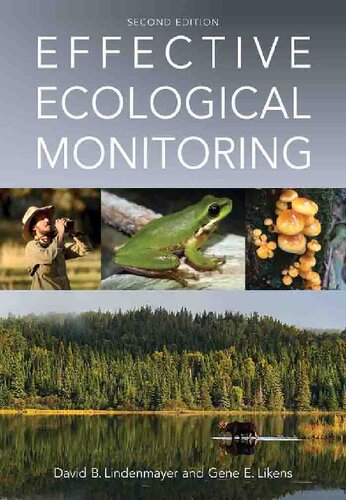

Most ebook files are in PDF format, so you can easily read them using various software such as Foxit Reader or directly on the Google Chrome browser.
Some ebook files are released by publishers in other formats such as .awz, .mobi, .epub, .fb2, etc. You may need to install specific software to read these formats on mobile/PC, such as Calibre.
Please read the tutorial at this link. https://ebooknice.com/page/post?id=faq
We offer FREE conversion to the popular formats you request; however, this may take some time. Therefore, right after payment, please email us, and we will try to provide the service as quickly as possible.
For some exceptional file formats or broken links (if any), please refrain from opening any disputes. Instead, email us first, and we will try to assist within a maximum of 6 hours.
EbookNice Team

Status:
Available0.0
0 reviews
ISBN 10: 1486308929
ISBN 13: 978-1486308927
Author: David Lindenmayer, Gene E. Likens
Long-term monitoring programs are fundamental to understanding the natural environment and managing major environmental problems. Yet they are often done very poorly and ineffectively. This second edition of the highly acclaimed Effective Ecological Monitoring describes what makes monitoring programs successful and how to ensure that long-term monitoring studies persist.
The book has been fully revised and updated but remains concise, illustrating key aspects of effective monitoring with case studies and examples. It includes new sections comparing surveillance-based and question-based monitoring, analyzing environmental observation networks, and provides examples of adaptive monitoring.
Based on the authors’ 80 years of collective experience in running long-term research and monitoring programs, Effective Ecological Monitoring is a valuable resource for the natural resource management, ecological and environmental science and policy communities.
Chapter 1
Introduction
Some of the ecological values and uses of long-term datasets
Time until expression
Informing policies and legislation in environmental management
Use in simulation modelling
Tests of ecological theory
Development of co-located, collaborative and multidisciplinary work
Detection of surprises
Poor record of long-term ecological monitoring
Why we wrote this book
1. Societal need
2. Correcting the record - countering the perception that long-term studies in ecology are poor quality science
3. Making sense of the vast monitoring literature
4. Providing an overview of success and failure
5. New perspectives
References
Chapter 2
Why monitoring fails
Characteristics of ineffective monitoring programs
Failure to ask the preliminary and fundamental question - Is monitoring needed at all?
Passive, mindless and lacking questions
Lack of trigger points for action
Poor experimental design
Snowed by a blizzard of ecological details
Squabbles about what to monitor - 'It's not monitoring without the mayflies'
Big machines that go 'bing'
Disengagement
Rush to get 'real work' happening on the ground and accusations of program
over-engineering
Poor data management
Breaches of data integrity
Other factors contributing to ineffective monitoring programs
Lack of funding - grant myopia
The loss of a champion
Out of nowhere
Excessive bureaucracy
Summary
References
Chapter 3
What makes long-term monitoring effective?
Characteristics of effective monitoring programs
Good questions and evolving questions
The use of a conceptual model
Selection of appropriate entities to measure
Good design
Well-developed partnerships
Strong and dedicated leadership
Potential to identify key emerging issues
Ongoing funding
Frequent use of data
Scientific productivity
Maintenance of data integrity and calibration of field techniques
Little things matter a lot! Some 'tricks of the trade'
Field transport
Field staff
Access to field sites
Time in the field
The adaptive monitoring framework
Examples of the adaptive monitoring framework
Adaptive monitoring is a general and not a prescriptive framework
Increased future role for adaptive monitoring
Summary
References
Chapter 4
The problematic, the effective and the ugly - some case studies
The problematic
PPBio Australasia
The Alberta Biodiversity Monitoring Program (ABMP)
EMAP
The effective
Rothamsted
Ecosystem Health Monitoring Program (EHMP) for Moreton Bay in
South East Queensland, Australia
The Hubbard Brook Ecosystem Study
The Central Highlands of Victoria, south-eastern Australia
Need to wait and see
NEON/TERN
The ugly
Summary
References
Chapter 5
The upshot - our general conclusions
Changes in culture needed to facilitate monitoring
The academic culture and rewards systems
Structure of organisations
Funding
Societal culture
Good things that can come from non-question based monitoring
The role of citizen science in long-term monitoring
The challenge of intellectual property and data sharing
The challenges in effective monitoring of rare, threatened and endangered species
The major challenge of keeping monitoring and long-term studies going
The big issue of integrating different kinds of monitoring
Approaches to integrate data from different kinds of monitoring
The challenges posed by differences in the kinds of entities that are monitored in different ecosystems
Using environmental and economic accounts as a way to demonstrate the value of monitoring and cement support for monitoring in place
Concluding remarks
References
effective ecological monitoring
what is ecological monitoring
benefits of environmental monitoring
effectiveness monitoring
effective monitoring and alerting
Tags: David Lindenmayer, Gene Likens, Effective ecological monitoring